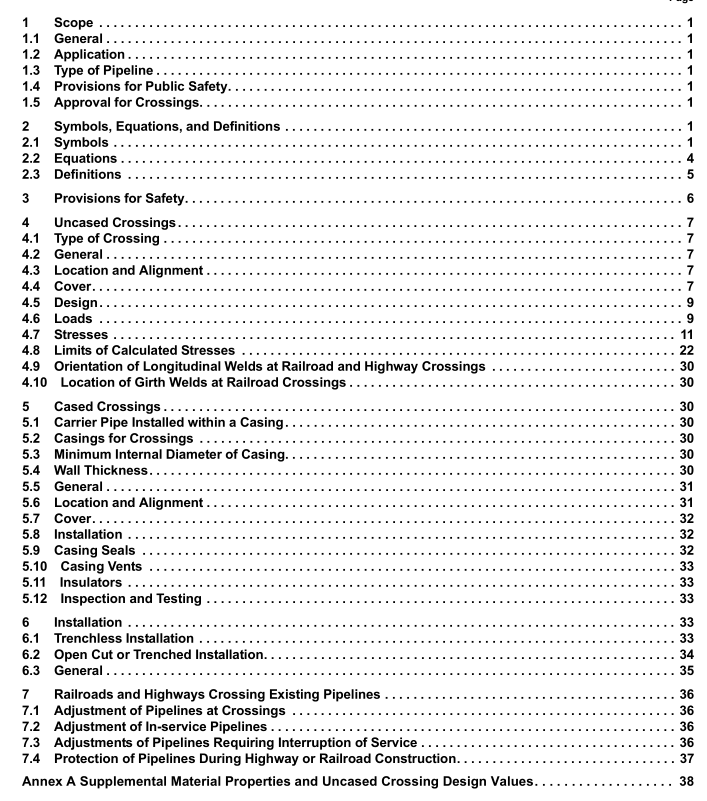API 1102 pdf download

API 1102 pdf download Steel Pipelines Crossing Railroads and Highways
2.3.10
maximum allowable operating pressure (MAOP)or maximum operating pressure (MOP)
The maximum pressure at which a pipeline or segment of a pipeline may be operated with limits as determined byapplicable design codes and regulations.
2.3.11
percussive moling
A construction method in which a device is used to advance a hole as sections of pipe are jacked simultaneously intoplace behind the advancing instrument.
2.3.12
pipe jacking with auger boring
A construction method for pipeline crossings in which the excavation is performed by a continuous auger as sectionsof pipe are welded and then jacked simultaneously behind the front of the advancing auger.
2.3.13
pressure testing
A continuous,uninterrupted test of specified time duration and pressure of the completed pipeline or piping systems,or segments thereof, which qualifies them for operation.
2.3.14
railroad
Rails fixed to ties laid on a roadbed providing a track for rolling stock drawn by locomotives or propelled by selr-contained motors.
2.3.15
rigid pavement
Highway surface or subsurface made of Portland cement concrete.
2.3.16
split casing
A casing made of a pipe that is cut longitudinally and rewelded around the carrier pipe.
2.3.17
trenchless construction
Any construction method, other than directional dirling,for installing pipelines by subsurface excavation without theuse of open trenching.
2.3.18
uncased pipeline or uncased pipe
Carrier pipe without a casing that crosses beneath a railroad or highway.3Provisions for Safety
3.1 The applicable regulations of federal, state,municipal or other regulating bodies having jurisdiction over thepipeline or the facility to be crossed shall be observed during the installation of a crossing.
3.2 As appropriate to the hazards involved, guards(watch persons) should be posted;warning signs, lights, andflares should be placed; and temporary walkways, fences, and barricades should be provided and maintained.
3.3 Permission should be obtained from an authorized agent of the railroad company before any equipment istransported across a railroad track at any location other than a public or private thoroughfare.
3.4The movement of vehicles, equipment, material, and personnel across a highway should be in strict compliancewith the requirements of the appropriate jurisdictional authority. Precautionary and preparatory procedures should be used, such as posting flagpersons to direct traffic and equipment movement and protecting the highway from surfaceor structural damage.Highway surfaces should be kept free of dirt, rock,mud, oil, or other debris that present anunsafe condition.
3.5 Equipment used and procedures followed in constructing a crossing should not cause damage to, or makeunsafe to operate, any structure or facility intercepted by or adjacent to the crossing.
3.6 The functioning of railroad and highway drainage ditches should be maintained to avoid flooding or erosion ofthe roadbed or adjacent properties.
4Uncased Crossings4.1Type of Crossing
The decision to use an uncased crossing must be predicated on careful consideration of the stresses imposed onuncased pipelines, versus the potential difficulties associated with protecting cased pipelines from corrosion. Thissection focuses specifically on the design of uncased carrier pipelines to accommodate safely the stresses anddeformations imposed at rairoad and highway crossings. The provisions apply to the design and construction ofwelded steel pipelines under railroads and highways.
4.2General
4.2.1 The carrier pipe should be as straight as practicable and should have uniform soil support for the entre lengthof the crossing.
4.2.2The carrier pipe should be installed so as to minimize the void between the pipe and the adjacent soil.
4.2.3 The carrier pipe shall be welded in accordance with the latest approved editions of API Standard 1104,Welding of Pipelines and Related Facilities [7], and ASME B31.4 or B31.8 [8,9], whichever is applicable.
4.3Location and Alignment
4.3.1 The angle of intersection between a pipeline crossing and the railroad or highway to be crossed should be asnear to 90 degrees as practicable. ln no case should it be less than 30 degrees.
4.3.2 Crossings in wet or rock terrain, and where deep cuts are required, should be avoided where practicable.4.3.3Vertical and horizontal clearances between the pipeline and a structure or facility in place must be sufficient topermit maintenance of the pipeline and the structure or facility.
4.4Cover
4.4.1Railroad Crossings
Carrier pipe under railroads should be installed with a minimum of cover, as measured from the top of the pipe to thebase of the raill, as follows (see Figure 1):









